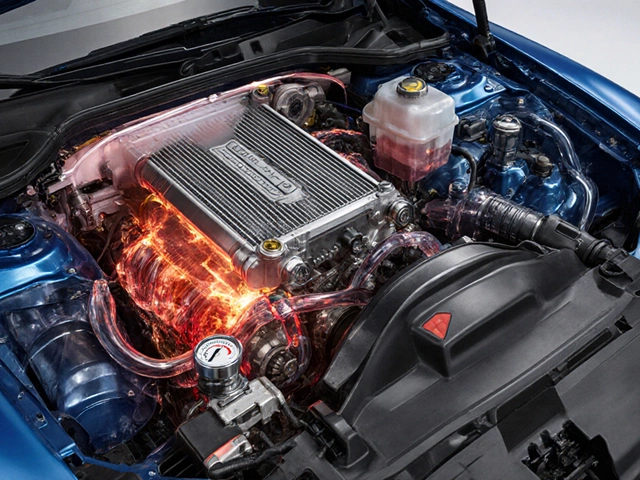Ever hop into your car on a sweltering day, crank up the AC, and all you get is a weak lukewarm breeze instead of that refreshing Arctic blast? Annoying, right? Before you consider taking a sledgehammer to your dashboard, let’s look at some practical fixes.
Your car's AC not cooling effectively could be due to several issues, and your first job is to figure out the culprit. A common reason is low refrigerant levels. Without enough refrigerant, even the best AC system can turn into a glorified fan. But it's not just about topping it up; there's often a reason it's low you need to address. Could be a pesky leak.
Check the radiator and condenser. These components need to be in top shape to keep things chilly. Sometimes debris or road dirt clogs them up; it’s like putting a blanket over a fan.
- Understanding Your Car AC
- Common Problems Affecting Cold Air
- Steps to Diagnose AC Problems
- DIY Fixes for a Cold Car AC
Understanding Your Car AC
Your car AC works a bit like your fridge at home but designed to cool a much bigger space at a faster rate. At its core, the system relies on a compressor, condenser, evaporator, and refrigerant. Knowing how these parts work can help you pinpoint what might be wrong when the air stops blowing cold.
The Role of the Compressor
The compressor is the heart of the system. It pressurizes the refrigerant and pumps it through the AC system. If your compressor is on the fritz, the rest of the system can't function properly. Keep an ear out for any strange noises or vibrations.
"A reliable compressor is key to efficient cooling," says auto expert Jane Davids. "Without it, you might as well use a hand fan."
Condenser and Radiator Function
The condenser sits in front of the radiator where it cools down the refrigerant by turning it into a liquid. Blockages here can seriously mess with your AC’s chill factor. Check for debris that might have accumulated, especially if you frequently drive on dirt roads.
Evaporator and Refrigerant
The evaporator is inside your car and absorbs heat from the air, removing moisture and radiating the cold air you crave on hot days. If you notice a musty smell, it could mean mold or mildew in the evaporator coils.
The refrigerant is vital as it’s the substance that cycles between gas and liquid states to facilitate cooling. Without enough refrigerant, cold air production is compromised. Most issues stem from leaks, so it's worth checking connections and seals regularly.
To give you a better picture of how long your AC components are expected to last, here’s an insight based on average car maintenance:
| Component | Average Lifespan |
|---|---|
| Compressor | 8-10 years |
| Condenser | 10-15 years |
| Evaporator | 15+ years |
Understanding these parts not only helps with troubleshooting but also informs preventive care to keep your car AC cold and stress-free during your drives.
Common Problems Affecting Cold Air
When your car's AC isn't blowing cold air, it can feel like the world's falling apart. But fear not! A few typical issues are often to blame, and we're here to break them down for you.
Low Refrigerant Levels
Think of the refrigerant as the lifeblood of your AC system. Without enough of it, your AC can't effectively cool down the air. Low refrigerant is usually due to leaks, which can be sneaky and hard to spot initially. Using a UV leak detection kit can help you find these elusive troublemakers.
Clogged Radiator and Condenser
The car radiator and condenser can become clogged with debris and dirt over time. This buildup prevents your AC from doing its thing, leading to warmer air. Regularly cleaning these parts can restore performance quickly, using nothing more than a garden hose in some cases.
Faulty Compressor
Your compressor is like the heart of your AC system, responsible for circulating the refrigerant. If it breaks or malfunctions, your AC's cooling power drops dramatically. Listen for strange noises or check if only warm air comes out when running it, as these are red flags.
Circuit or Electrical Problems
Sometimes the issue can be as straightforward as a blown fuse or a faulty switch blocking electricity flow. Check your car's electrical system for these minor hiccups. A busted AC clutch or a worn-out relay may also be responsible.
Identifying these problems early can save you a world of trouble, and often even a visit to the mechanic. Next, we'll speak about diagnosing these issues and how to get your cold car air flowing again.

Steps to Diagnose AC Problems
When your car AC isn't cooling right, it’s like having a fridge full of food with no power—pretty useless. Let’s look at some steps to pinpoint why your AC isn’t delivering the arctic breeze you crave.
Step 1: Check the Fan
First things first, make sure the fan is actually blowing air. Sometimes, a problem as simple as a fan not working properly can be the root cause. Turn your AC to max and listen carefully. If you don't hear the usual fan whir, there might be a fault in the blower motor.
Step 2: Inspect Refrigerant Levels
The refrigerant is essential for cooling action. If there’s not enough, your AC becomes ineffective. Leaks are often the sneaky culprit here. Use a refrigerant pressure gauge to check the levels or take it to a professional for a leak test.
Step 3: Examine the Condenser
The condenser is the part that looks like a small radiator at the front of your car. It's responsible for converting refrigerant from gas back into liquid. Debris or dirt can block airflow, so inspect it for any obstructions. A careful clean can sometimes do wonders.
Step 4: Listen for Unusual Noises
Strange sounds, like rattling or buzzing when you turn on the AC, could point to issues with the compressor. The compressor is the heart of your AC system and if it's not working right, cold air is just a dream.
Step 5: Smell for Unusual Odors
If your AC emits a funky smell, mold could be the cause. This happens when moisture doesn't evaporate properly. It's not just unpleasant; it’s unhealthy too. Consider using an antifungal spray to clean the evaporator or replace the cabin air filter.
Step 6: Check Electrical Connections
Lastly, inspect the electrical connections to the AC unit. Loose connections or blown fuses can interrupt the AC’s working. Ensure everything’s tight, and replace any blown fuses with the correct rating.
Quick Check Summary
| Component | Potential Issue |
|---|---|
| Fan | Blower malfunction |
| Refrigerant | Low levels or leaks |
| Condenser | Obstructions or damage |
| Compressor | Wear or damage |
| Electrical | Loose connections |
By following these steps, you'll have a much clearer idea of what’s going wrong with your car AC. With a little bit of sleuthing, you could steer clear of hefty repair bills and enjoy a cool car once again.
DIY Fixes for a Cold Car AC
So, you're eager to get your car AC back to its frosty glory? Let's roll up those sleeves and dig into some practical fixes you can tackle yourself.
Check and Refill Refrigerant
More often than not, the root of a lackluster AC system is low refrigerant. Here's how you can check and refill it:
- Locate the AC service ports – usually found under the hood on the AC lines. The low-pressure port is where you'll connect the AC recharge kit.
- Get a can of refrigerant with a gauge. Attach it to the low-pressure side.
- Follow the instructions on the kit to refill to the correct pressure. Don't overfill; too much refrigerant can also cause issues.
If you’re refilling often, you’ve probably got a leak somewhere. You might need a pro to seal it.
Inspect the Radiator and Condenser
A clogged or dirty radiator and condenser can mess up your car's AC cooling performance. To clean it:
- Turn off your car and pop the hood.
- Gently hose down the radiator and condenser to remove dirt and debris. Be careful not to bend the fins.
- Check the condenser for any blockage or damage signs.
Replace the Cabin Air Filter
A dirty air filter can stunt cold air flow. Switching it out is an easy fix:
- Find out where your car’s cabin air filter is located – usually behind the glove box.
- Remove the old filter and slide in the new one.
- Consider a quality filter for better air quality inside your car.
Verify Compressor Functionality
Your compressor is the heart of your AC. Listen and look:
- With the AC on, check if the compressor engages by facing the engine bay. You should hear a click and see the compressor clutch engage.
- If the clutch doesn’t engage, it might be an electrical issue or a sign of a failing compressor. Seek professional help here.
All of these tweaks could potentially revive the chill in your car AC. Sometimes, a bit of TLC goes a long way. Keep an ear out for any strange noises and check these elements regularly to keep your car’s climate control running smooth!






